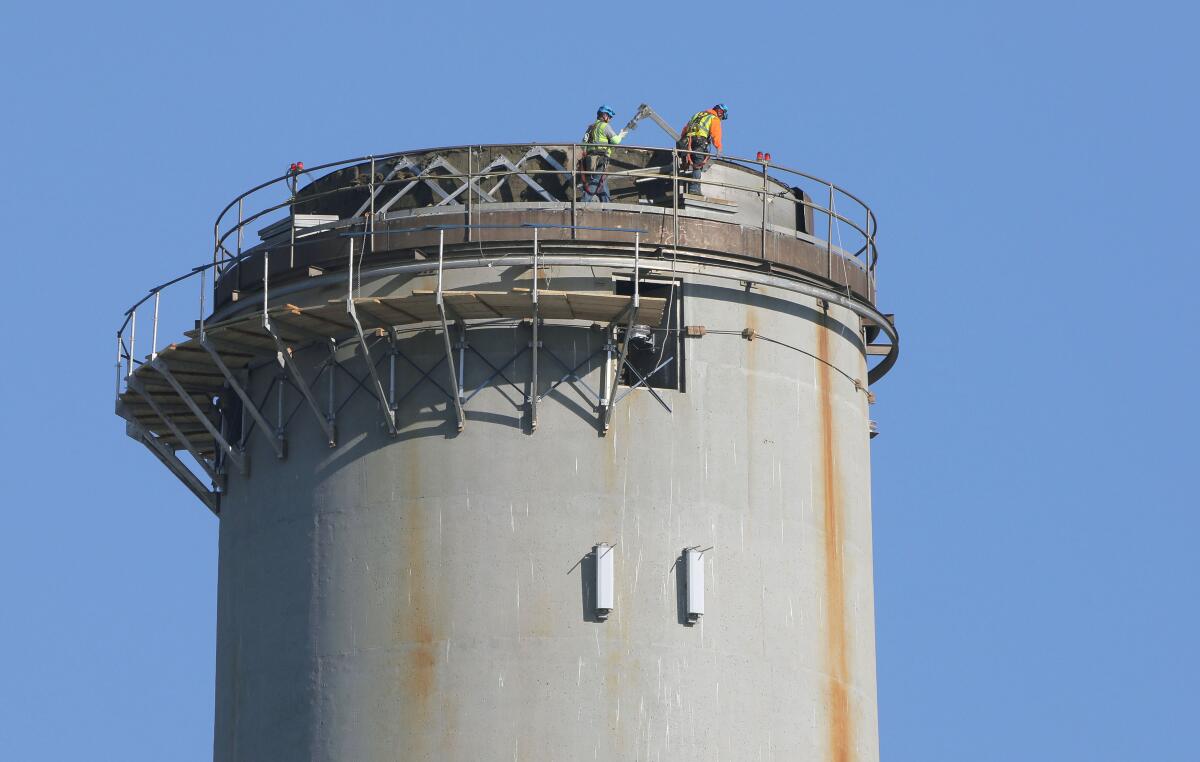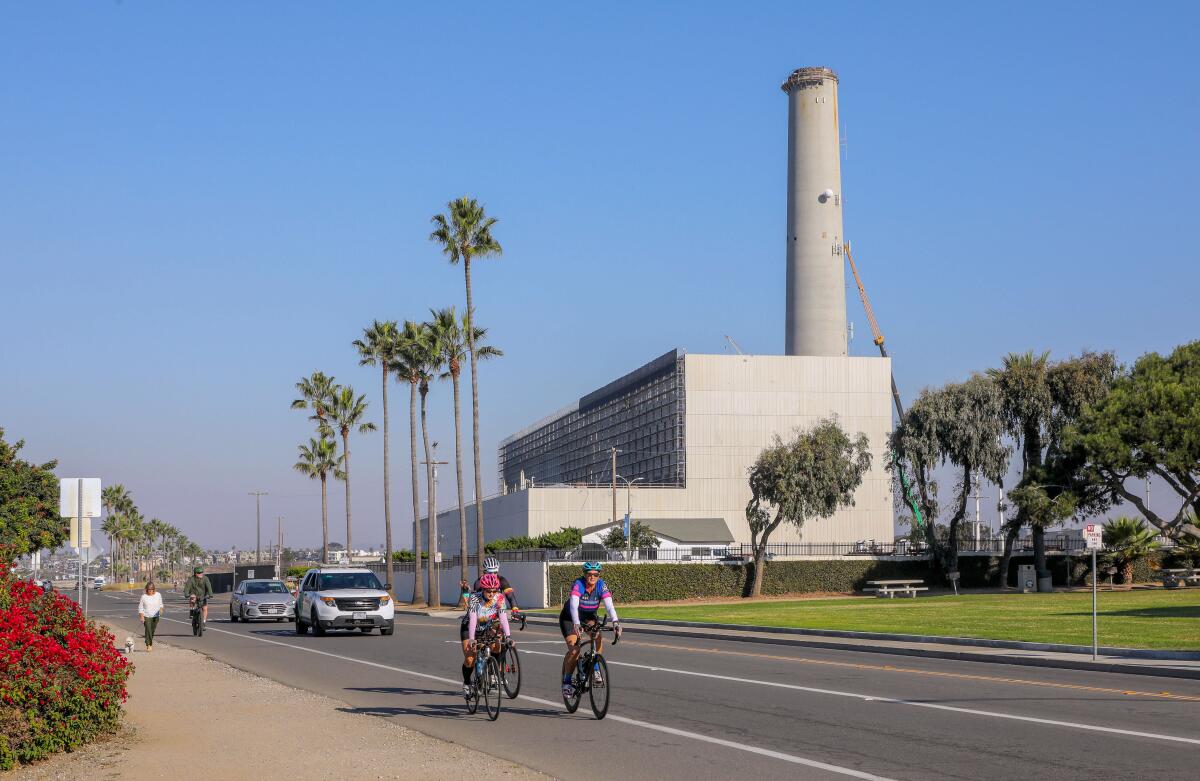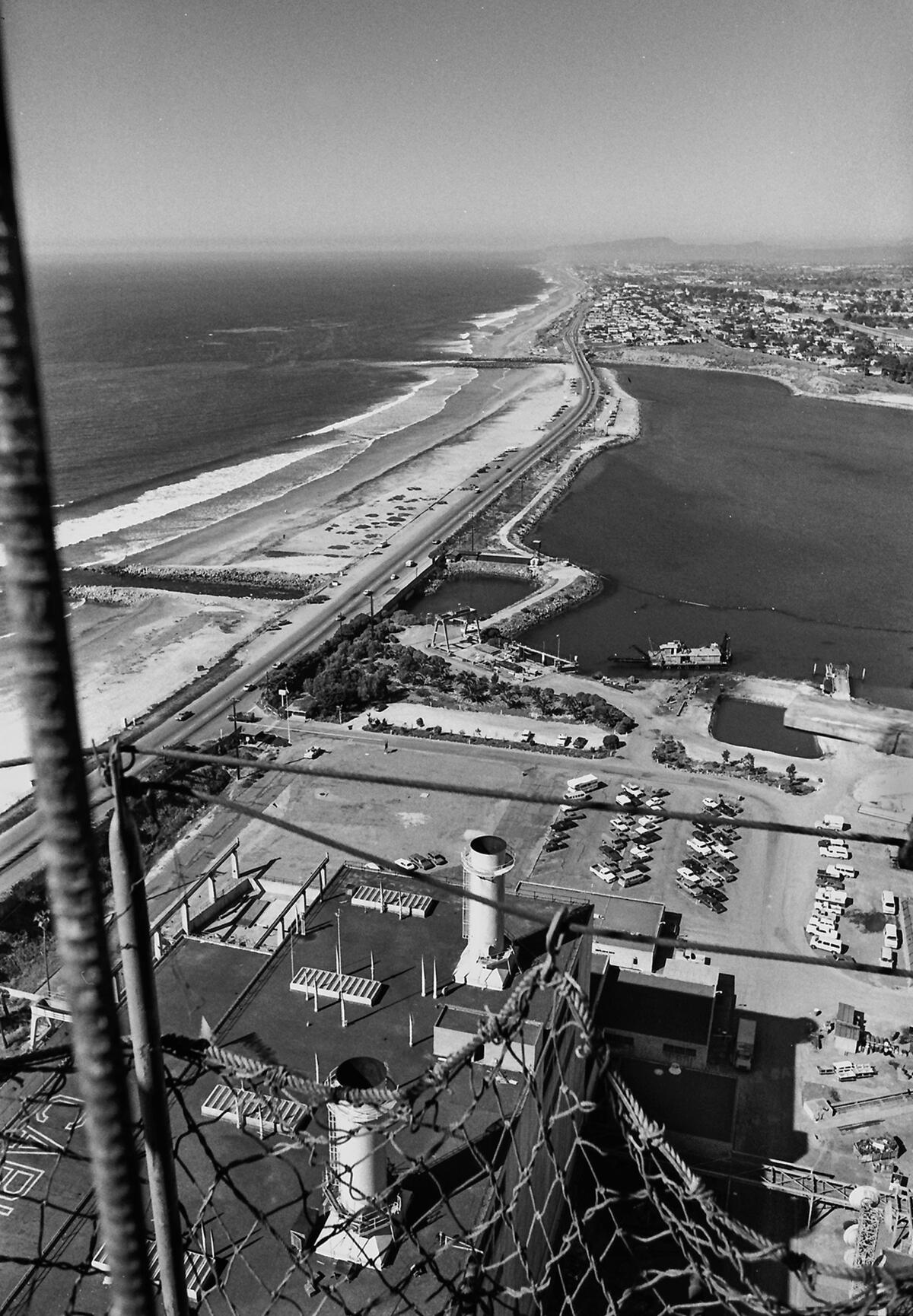Landmark Carlsbad smokestack coming down

- Share via
Anyone who’s driven past the Encina Power Station, a coastal Carlsbad landmark since the 1950s, can’t miss the changes in recent weeks.
Demolition of the old power plant is finally underway. Scaffolding lines the seaward side of the boxy concrete building, and there’s more at the top of its distinctive 400-foot-tall smokestack.
“Preparation for the Encina stack removal is ongoing and will wrap up by the end of 2020,” Chris Rimel, communications manager for plant owner NRG, said Thursday.
“The stack will come down in the first and second quarter of 2021,” he said. “A mechanical breaker mounted on the top of the stack will break the concrete in a top-down circular pattern, dropping the broken concrete down the center of the stack until about 60 feet of the stack remains. The rest of the stack will be removed by excavator equipment.”
To some people, the smokestack is an eyesore, while to others it is a welcome sign. Sailors at sea and aviators approaching McClellan-Palomar Airport in Carlsbad use the tall concrete column for navigation. Many a weary driver on the 5 Freeway sees it and knows that home is near.

Carlsbad resident Jim Strickland led an unsuccessful effort to preserve the chimney, if not the rest of the power plant, as part of a park or community building. He presented his ideas to the city’s Arts Commission, Historical Preservation Commission and the City Council, but to no avail.
“I thought it was a simple, obvious, sure thing for it to be designated as a historic landmark, but it wasn’t,” Strickland said.
NRG officials said there was no chance of preserving the stack. A contract signed in 2014 with San Diego Gas & Electric Co. and the city of Carlsbad requires the utility company to remove the entire plant, including the smokestack.
Initially one of the tallest structures on the West Coast, the smokestack was built in the 1970s to replace four shorter stacks as part of a $110-million upgrade of the power plant. Six workers died when a 190-foot crane collapsed during the construction.

NRG Energy officially retired the plant Dec. 11, 2018, after the company built a more efficient plant nearby on the same property.
Fueled by natural gas, the new plant can go from zero to its full power of 500 megawatts in just 10 minutes compared to the hours required for the old plant. The quick response can help meet the widespread need for air conditioning on a hot summer afternoon or the sudden demand in a natural disaster such as an earthquake or wildfire that takes down transmission lines.
Also, the new plant is air-cooled, so it doesn’t need the once-through seawater cooling system used by the old plant.
In November 2019, the city approved a nine-month extension for the demolition project so that the plant’s seawater intakes could continue to be used temporarily by the desalination plant that also operates on the property. Poseidon Water, which operates the desalination plant, installed its own intake pumps earlier this year.
Now the demolition is back on track and about 25% complete, Rimel said.
The process includes the removal of the exterior panels on the power block building, all exterior structures and equipment, and the generation equipment from inside the building, including some materials containing the hazardous material asbestos.
Asbestos is a naturally occurring mineral that was widely used for insulation in the 1950s. Years later, it was banned after doctors learned the airborne fibers were easily inhaled and can cause cancer and other diseases.
Any asbestos found at the plant will be packed in containers and shipped off for disposal under mandated guidelines, a process called abatement, before other work can begin.
The historic powerhouse, a beachfront building that housed generators that supplied electricity to the old Del Mar Hotel and part of the town in the 1920s, is structurally sound but the towering smokestack beside it is in sorry shape, an engineer has told city officials.
“Demolition wastes are managed as recyclable and non-recyclable materials,” Rimel said. “An estimated 34,000 tons of scrap metal will be recycled at a scrap metal facility, and 50,000 tons of concrete will be used onsite.”
Most of the crushed concrete will be used as fill to restore the site to its original grade before the plant was built.
“Batteries, used oils, and other wastes will be recycled when possible at approved facilities,” Rimel said. “Approximately 2,700 tons of abated asbestos and 1,500 tons of non-recyclable materials will be disposed of at approved landfills.”
The project’s contractor, Brandenburg Corp., Inc., is a 50-year-old Midwest-based company that specializes in demolition and environmental remediation.
About 200 people are working at the site, including NRG personnel, most of whom are from San Diego County and the surrounding counties. Because of the ongoing pandemic, the company follows COVID-19 protocols consistent with guidelines from the Centers for Disease Control.
“Personnel are temperature screened and respond to a health-check questionnaire before accessing the site each day,” Rimel said. “Personal protective equipment including masks are required.”
Demolition will completely remove the old building, smokestack and supporting structures and equipment, he said. The new SDG&E plant, the Carlsbad Desalination Plant and the Carlsbad Aquafarm all will remain on the site, most of which is owned by NRG. The Hubbs-SeaWorld fish hatchery that operates on SDG&E property on the north side of the lagoon also will stay.
What’s next is uncertain for the valuable piece of coastal real estate, which is designated as “visitor serving commercial and open space” in the city’s General Plan. A hotel, restaurants and a shopping center could be built under the existing zoning, but a decision is years away.
The site’s redevelopment depends on many factors including public participation, market conditions and the entitlement process, Rimel said.
Diehl writes for the San Diego Union-Tribune.
More to Read
Sign up for Essential California
The most important California stories and recommendations in your inbox every morning.
You may occasionally receive promotional content from the Los Angeles Times.











